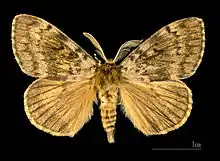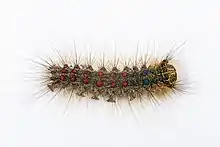Lymantria dispar
Lymantria dispar, the gypsy moth, is a species of moth in the Erebidae family. Lymantria dispar is subdivided into several subspecies, with subspecies such as L. d. dispar and L. d. japonica being clearly identifiable without ambiguity. Lymantria dispar has been introduced to several continents and is now found in Europe, Africa, Asia, North America and South America. The polyphagous larvae live on a variety of deciduous and coniferous trees[1] and can cause severe damage in years of mass reproduction. Due to these features, the gypsy moth is listed among the world's 100 most invasive alien species.
| Gypsy moth | |
|---|---|
 | |
| Mounted Lymantria dispar dispar male | |
_Female_Dos.jpg.webp) | |
| Mounted Lymantria dispar dispar female | |
| Scientific classification | |
| Kingdom: | Animalia |
| Phylum: | Arthropoda |
| Class: | Insecta |
| Order: | Lepidoptera |
| Superfamily: | Noctuoidea |
| Family: | Erebidae |
| Genus: | Lymantria |
| Species: | L. dispar |
| Binomial name | |
| Lymantria dispar | |
| Synonyms | |
| |

Subspecies
| Common name | Subspecies | Distribution | Identifying characteristics |
|---|---|---|---|
| European gypsy moth | Lymantria dispar dispar | Europe, western Asia and north Africa,[2]:6 introduced to Eastern North America | Females winged but flightless[2]:6 |
| Asian gypsy moth | Lymantria dispar asiatica | Eastern Asia,[2]:6 introduced to western North America[3] | Females winged and capable of flight; attracted to lights[2]:6 |
| Japanese gypsy moth | Lymantria dispar japonica | All of Japan[2]:6 | Large males, very dark brown color[2]:6 |
The European gypsy moth (Lymantria dispar dispar) is native to temperate forests in western Europe. It had been introduced to the United States in 1869, and to Canada in 1912.
The Asian gypsy moth (Lymantria dispar asiatica) is native to temperate Asia east of the Ural mountains. Since the early 1990s it has also been detected along the West Coast of temperate North America. From southern Europe it is spreading northwards into Germany and other countries, where it hybridizes with the European gypsy moth, L. d. dispar. A colony had been reported from Great Britain in 1995.
Pest control measures
In North America, the parasitoid chalcid wasp Ooencyrtus kuvanae was introduced as a biological control agent against the gypsy moth. The egg-parasitizing wasp is, however, not strictly host specific, as it also parasitizes the eggs of other Lepidoptera species.[4][5]
Etymology
Moths of the subfamily Lymantriinae are commonly called tussock moths due to the tussock-like tufts of hair on the caterpillars.[6]:9
The name Lymantria dispar is composed of two Latin-derived words. The generic name Lymantria means 'destroyer'.[7] The species epithet dispar means 'to separate' in Latin; it refers to the sexual dimorphism observed in the male and female imagines.[6]:9
Taxonomy
The North American gypsy moth and the European gypsy moth are considered to be the same subspecies, usually referred to as Lymantria dispar dispar.[2]:6 Confusion over the classification of species and subspecies still remains. The U. S. Department of Agriculture defines the Asian gypsy moth as "any biotype of L. dispar possessing female flight capability",[2]:5 despite L. d. asiatica not being the only accepted subspecies that is capable of flight.[2]:6 Traditionally, L. dispar has been referred to as "gypsy moth" even when referring to Japanese, Indian and Asiatic gypsy moth populations.[2]:5
References
- FAO - Profiles of selected forest pests
- Pogue, Michael. "A review of selected species of Lymantria Huber [1819]" (PDF). Forest Health Technology Enterprise Team. Retrieved September 14, 2012.
- "Asian Gypsy Moth Lymantria dispar asiatica". Pest Tracker National Agricultural Pest Information System. Retrieved September 14, 2012.
- Christenson, Amy (June 1997). "Know Your Friends". Midwest Biological Control News. Archived from the original on 26 November 2018.
- Brown, M. W. (1984). "Literature review of Ooencyrtus kuvanae [Hym.: Encyrtidae], an egg parasite of Lymantria dispar [Lep: Lymantriidae]". Entomophaga. 29 (3): 249–265. doi:10.1007/BF02372112.
- The Gypsy Moth: Research Toward Integrated Pest Management, United States Department of Agriculture, 1981
- Free Dictionary for Lymantria
External links
| Wikimedia Commons has media related to Lymantria dispar. |
- Gypsy moth on UKmoths
- Gypsy moth in Morocco
- Bugguide.net
- Species Profile: European Gypsy Moth (Lymantria dispar) from the National Invasive Species Information Center, United States National Agricultural Library